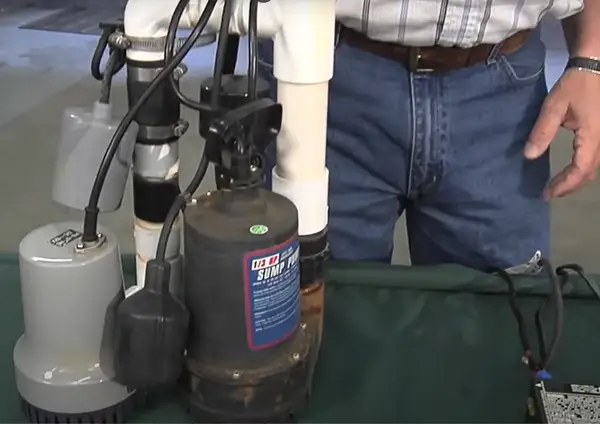When constructing a new home, or buying a new home, ensuring its protection against flooding should be a top priority. A backup sump pump in new homes plays a critical role in safeguarding your basement from water damage.
This often-overlooked addition provides an extra layer of security, preventing costly repairs and preserving your belongings during unforeseen circumstances like power outages or pump failures.
Table of Contents
What Is a Backup Sump Pump?
A backup sump pump is an additional pump installed alongside the main sump pump. It acts as a safety net in case the primary pump fails. The backup pump kicks in when the main pump stops working due to power outages, mechanical failure, or overwhelming amounts of water. With this system in place, you can be confident your basement will remain dry, even when issues arise with the main pump.

Why Should You Install a Backup Sump Pump in New Homes?
Your home is an investment. Protecting it with a backup sump pump in new homes is crucial for several reasons.
First, many homes are built in areas with a high water table or prone to heavy rain. In these regions, flooding can occur without warning.
Second, sump pump failures are not uncommon. They can fail due to power outages, clogging, or even mechanical wear.
A backup sump pump helps avoid costly damage to your foundation and belongings. Without one, water could quickly ruin carpets, furniture, or valuable electronics.
Protecting Your Home from Flooding
Flooding is one of the biggest threats to homes, especially those with basements. Water can seep in through the foundation or enter through windows and doors.
If a sump pump is your first line of defense, then the backup pump acts as your second line. With a backup sump pump in new homes, you can avoid worrying about an unexpected failure.
If there’s an issue with the main pump, the backup will keep the water at bay, ensuring your home stays dry.
In addition to having a sump pump, new homeowners need flood insurance and sump pumps to fully protect their property.
How a Backup Sump Pump Works
The backup sump pump is designed to work automatically. It’s usually powered by either a battery or a water-powered system.
The battery-powered backup pump kicks in when the main pump fails or during a power outage.
If your home relies on municipal water, a water-powered backup pump uses water pressure to pump excess water out of your basement.
In case you’re not sure what you’re doing, it’s helpful to use checklists from trusted resources. Moving companies like Slater Transfer & Storage offer practical advice to make sure you cover essential tasks—such as checking the plumbing and similar essentials. Either way, your backup pump operates automatically, giving you peace of mind.
Types of Backup Sump Pumps
There are two main types of backup sump pumps to consider: battery-powered and water-powered.
Homeowners could install a battery backup pump themselves. However, water powered backup systems should be installed by a local plumber.
Battery-Powered Backup Sump Pump
Battery-powered pumps are the most common type. They come with a battery that charges while the main pump is running. If there’s a power failure, the backup pump automatically turns on and uses the stored battery power to keep the pump running. Some models are equipped with an alarm to alert you when the battery is low or when the backup pump is running.

Water-Powered Backup Sump Pump
This type uses water pressure to operate. It doesn’t rely on electricity, which makes it a good choice during a power outage. The water-powered pump operates using the water supply from your home. If there’s no power, this system will still work as long as your water supply is intact.
Both types have their benefits, and the choice largely depends on your needs and preferences, so make sure to choose the water pump that suits your home.

Signs You Need a Backup Sump Pump in Your New Home
Some homeowners may wonder if they really need a backup sump pump. There are several signs that suggest installing one is a wise decision:
- Frequent Power Outages: If your area experiences frequent power outages, a battery-powered backup pump can be a lifesaver.
- Heavy Rainfall: Areas with heavy or frequent rainfall are more prone to basement flooding. A backup sump pump will provide added protection.
- Clogging Issues: Sump pumps can get clogged with debris, which can lead to failure. A backup pump ensures that even if the primary pump is clogged, water will still be removed.
- Old or Unreliable Pump: If your home already has a sump pump that’s old or unreliable, it’s time to invest in a backup. You don’t want to wait until the pump fails during a heavy rainstorm.
How a Backup Sump Pump Saves Money
Flood damage can be incredibly expensive to repair. Water damage to the foundation, walls, and belongings can quickly add up. Without a backup sump pump, the main pump might fail just when you need it the most.
This could lead to expensive repairs, ruined furniture, or destroyed appliances. By investing in a backup sump pump in new homes, you’re making a cost-effective decision that prevents long-term financial stress.
The cost of installing a backup sump pump is relatively low compared to the potential cost of water damage. You can protect your home and keep your repair bills to a minimum.
Maintenance Tips for Backup Sump Pumps
Like any piece of equipment, backup sump pumps need regular maintenance to ensure they work effectively. Here are some tips to keep your backup sump pump in top condition:
- Test Regularly: Test the backup pump every few months to make sure it’s working. If it’s battery-powered, check the battery level.
- Inspect the System: Periodically check the system for any signs of wear or damage. If you notice any issues, address them before they become a bigger problem.
- Keep It Clean: Make sure the sump pit is free of debris and dirt. Clogged pumps are more likely to fail.
- Replace Batteries When Necessary: For battery-powered backups, it’s important to replace the batteries every few years to ensure proper functioning.
- Consider Sump Pump Replacement: If your backup sump pump is older or malfunctioning, it may be time for a sump pump replacement. Replacing an old or faulty pump can prevent issues and ensure reliable protection for your home.
By following these simple maintenance steps, you can extend the life of your backup sump pump and ensure it operates when you need it most.
Is a Backup Sump Pump Worth the Investment?
While adding a backup sump pump to a new home may seem like an additional cost, it’s a smart investment. The peace of mind it provides is priceless. No homeowner wants to deal with water damage, especially in a new home.
A backup sump pump is a small price to pay to avoid expensive repairs and the hassle of cleaning up after a flood. It adds an extra layer of protection, ensuring that your home remains safe and dry no matter what happens with the main sump pump.

Secure Your Home with a Backup Sump Pump
Installing a backup sump pump in new homes is one of the best ways to protect your property from water damage. It provides a safeguard against pump failures, power outages, and heavy rainfall.
Whether you choose a battery-powered or water-powered model, the backup pump ensures that your basement stays dry and your home stays safe. Don’t wait for disaster to strike—protect your investment today. A backup sump pump in a new home is an easy way to ensure long-term security.

Author at Best Sump Pumps
The first time I helped to install a drain tile and basement sump pump system was 1978.
Since then I have worked for a city water utility where I worked with and maintained pumps.
My rental properties and personal homes all needed sump pumps.
As a modular home dealer/builder, those new homes needed sump pumps.
I put that experience to good use by providing reliable, useful, and practical advice on buying, using, and maintaining sump pumps.
